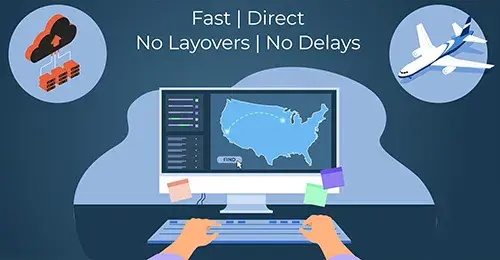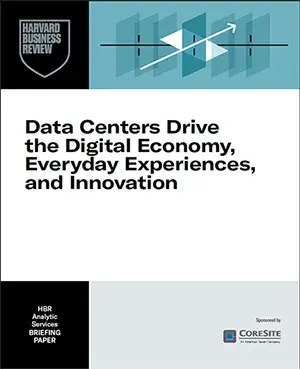
Taking the Fast Lane: Direct vs. Indirect Cloud Connections
Imagine you are planning a cross-country trip. You’re on the internet, looking at options for airline reservations. One flight takes you directly to your destination – no layovers, no delays and no lost luggage (probably). Another flight makes three stops, so you’re switching planes and navigating crowded terminals. You’ll get to your destination either way, but one journey is faster, more reliable and far less stressful.
What are you going to choose? Hmm ...
That’s just like the difference between direct cloud connections and indirect, third-party network routing. Both connect your business to the cloud, but how you get there determines the speed, performance, security and control of your data’s journey.
What is Direct (Native) Cloud Connection?
A direct cloud connection, also known as a native cloud on-ramp, provides a private, high-bandwidth link between your infrastructure and a public cloud provider’s network. If you are reading closely, you noticed that “native” is included in the way we describe the connection. That’s because it’s on-net; it does not rely on external networks or third-party providers.
Instead of routing data across the public internet, your traffic enters the cloud provider’s backbone directly – typically through a cross connect in a data center. Then it travels within the data center provider’s private network, avoiding congestion and the unpredictable performance of public internet paths.
Every major cloud provider offers its own version of a native cloud on-ramp, including AWS Direct Connect, Microsoft Azure Express Route, Google Cloud Interconnect and Oracle FastConnect. These are deployed in select, carrier-neutral data center facilities, providing direct access to major cloud ecosystems and interconnection partners in a data center or data center campus.
What is Indirect (Third-Party) Cloud Connection?
An indirect cloud connection is a path to the cloud that relies on one or more third-party networks between your infrastructure and the cloud provider’s backbone. Instead of establishing a private, direct link to the cloud environment, your traffic travels across intermediary carriers, ISPs or network exchange platforms that manage portions of the route.
Indirect connections can be faster to deploy and less expensive up front, making them a practical choice for lighter workloads or early-stage cloud strategies. However, because these paths typically involve multiple networks and domains, performance will vary depending on the traffic conditions, peering agreements and quality of each intermediary’s infrastructure.
While this can deliver “decent” performance, it is inherently variable, and each stop (“hop”, as we say in the data center industry) along the way adds more potential for latency, cost and point-of-failure.
Why Route Efficiency Matters
Every hop your traffic makes – from one network to another – introduces delay and risk. With direct on-ramps via a colocation facility, your data takes the shortest and most controlled route. With indirect connections, data travels through multiple providers before reaching its destination; increasing potential points of failure. To put it simply, a native on-ramp is the fast lane. Indirect connection is the scenic route.
For latency-sensitive workloads like financial transactions, AI inference, or real-time streaming, that difference can be critical. Even small reductions in delay can translate to significant improvements in user experience and business outcomes.
| Direct (Native) Cloud Connection | Indirect (Third-Party) Cloud Connection | |
| Performance | Consistent, low latency via private backbone | Variable |
| Security | Private connection, no public internet exposure | May traverse public or shared networks |
| Reliability | SLA-backed, predictable throughput | Varies by provider; more points-of-failure |
| Scalability | Easily scales bandwidth within on-ramp | Limited by carrier or ISP capabilities |
| Cost | Higher initial setup cost, but lower egress fees | Lower up-front cost, possible long-term inefficiencies |
| Best For | Mission-critical, latency-sensitive workloads | General business workloads, distributed apps |
Why Colocation Matters
Colocation isn’t just about housing servers – it’s also about strategic connectivity. For businesses running AI workloads, real-time analytics, performance, reliability and speed are non-negotiable. For mission-critical applications such as emergency services, healthcare, utilities, transportation and communication, the reliability and speed of cloud connections are vitally important.
One key advantage: According to CoreSite’s 2025 State of the Data Center Report, 51% of IT leaders identify direct connection to cloud providers as a top capability for AI and high-performance workloads.1
When you partner with CoreSite, you not only gain access to native cloud on-ramps, but also a rich ecosystem of networks, exchanges and partners under one roof. This is critical because not all data center providers offer true direct cloud connectivity, even though they might say they do.
By colocating with CoreSite, businesses can achieve:
- Simplified multicloud access: Connect to major cloud providers without managing multiple carriers.
- Predictable performance: Reduce latency and boost throughput for critical workloads.
- Enhanced security and compliance: Keep traffic on private links rather than the public internet.
- Agile, economic multicloud management: Scale and adapt your infrastructure with minimal operational overhead.
- Ecosystem leverage: Tap into a dense network of interconnection partners to optimize business outcomes.
With ~90% of organizations adopting a hybrid cloud approach by 2027, colocation and direct cloud connection matters more than ever.2 The fast lane starts with direct cloud on-ramps, keeping critical workloads moving at full speed.
Know More
To help technology leaders navigate the evolving demands of hybrid IT, Harvard Business Review Analytic Services in association with CoreSite commissioned an in-depth report on the future of digital infrastructure. This independent analysis highlights how enterprises are using colocation and interconnection to:
- Power AI and data-intensive workloads
- Improve sustainability and operational efficiency
- Create scalable, future-ready environments
Get the Harvard Business Review Analytic Services Report
References
1. 2025 State of the Data Center Report, CoreSite
2. Worldwide Public Cloud End-User Spending to Total $723 Billion in 2025, Gartner












